Natural Rock Drawer Knobs and Cabinet Pulls

The 1% that's Not really the 1%

On Knobs.co, you'll find over 50,000 unique cabinet knobs and pulls.
Overkill?
Perhaps. Especially when you consider that they all perform the same, very basic function. They just open cabinet doors. Go to your local cabinet maker and you'll find they offer 10, may 20 different types of cabinet doors. So why should cabinet hardware come in 1000 times more varieties? Easy!
If you have white kitchen cabinets, there are literally millions of other homes across the US that have cabinets almost identical to yours. Yet, it's your choice of accents, like cabinet knobs and pulls, that make your house distinct from those others, that make it feel like your home.

At Knobs.co, we've made it our mission to match our clients with their ideal hardware.
HOW?
By changing the way you shop for hardware.
In this guide, we'll give you a quick overview of everything you need to know about hardware, plus teach you how to best use the industry leading tools and services we've created to make your shopping experience a pleasure.
With that, let's dig in!
contents
- 04 Master the Tools to Find the Right Hardware
- 11Choosing the Right Type of Hardware
- 12Factors that will Guide your Choice
- 17A Few Basic Definitions
- 18Tips on Positioning and Installing Hardware
- 24Know Your Knob Shapes
- 25Know Your Pull Shapes
- 26Looking at Different Design Styles
- 29Finding the Right Brand
- 30Cabinet Hardware Base Materials
- 33Cabinet Hardware Finishes
- 34The Most Popular Finish Treatments
- 35A Little More About Bronze Finish Treatments
- 36The Rest of Our Offering
Master the tools to find the ideal
Hardware for your Kitchen
Before we get into the extensive cabinet hardware options, we're first going to give you an overview of the tools we've built at Knobs.co.
Why? Because our custom-built tools are the key to making our giant catalog a breeze for you to navigate.
Here is a brief overview of the primary tools and services we've created to match you to your ideal hardware.
![]()
Master tools
Faceted Search
The key to searching a gigantic catalog is to be able to drill down from a huge number of results to a handful in as few clicks as possible.
We've custom designed our faceted search to allow you to sort your results via all of our main categories, including the type of hardware, the finish, size, brand, style, and more.
The more information you can give us about what it is that you're looking for, the more accurate we can find that ideal item.

![]()
Master tools
Search by Image or Pin
Great as our text based search is, if you're trying to match something you've seen in person, in a magazine, or online, text is not the easiest place to start.
Knobs.co won an innovation award for our image based search. Just upload any image and click search!

![]()
Master tools
Samples, Samples, Samples!
Want to see your items in person before you buy? Great idea! Our samples program is set up to help you do just that. Order several samples at their normal price, and after you place your final order, we'll refund you the cost of the items you didn't choose. This way, you've lost nothing by trying out multiple items.
There are specific terms and conditions that apply to this program, so make sure that you read and understand our samples policy.
Get full details and learn about qualifying orders on our Samples page.

![]()
Master tools
Free Design Consultations
Of course, technology will only get you so far. Fortunately, our team of interior designers is ready to close the gap.
Our designers have been trained to find the best possible solution to even the most challenging kitchen problem, so whether you are struggling with the right finish or don't know which style to choose, they are there to guide you towards your ideal kitchen.
To work one on one with an in-house interior designer, Sign up for a Free Design Consultation here.

![]()
Master tools
Visualizer App
Want to preview how a knob will look against your cabinets? On each product page, you can upload a picture of your cabinets, and the knob will show up superimposed on top. Just hit the Visualizer button beneath the product image.
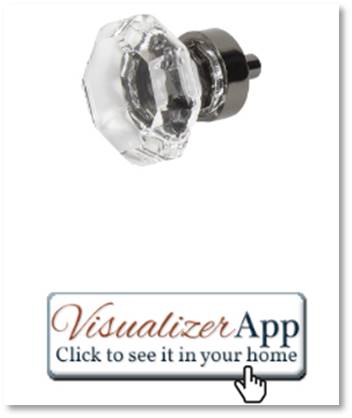


![]()
Master tools
Trade Professionals Program
As a member of our Trade Professionals Program, you will be assigned a dedicated account manager, and enjoy preferential pricing, service, and rewards.
Click here to apply now!

Choosing the right
Type of Hardware
It always comes down to Knobs vs Pulls. It's a question we get asked quite often and sometimes the answer is obvious.

For heavy drawers or appliances, you'll want to go with pulls, ideally appliance grade.
But for standard cabinets, there are far more options, with a lot of it coming down to personal preference.
We did a poll with our interior design clients, asking them if they prefer, knobs, pulls, or a combination of the two. A combination of knobs and pulls emerged as the overwhelming choice.
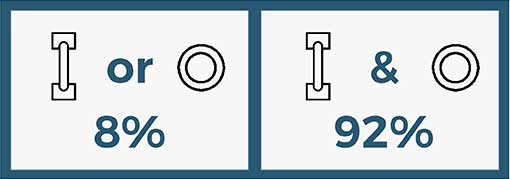
Knobs are installed with a single screw from the back of the cabinet or drawer front, while a pull usually has 2 screws. Unless you are very confident that you can drill these holes yourself, it is best to get a professional to drill the holes for you. Give them clear instructions and samples of your chosen hardware in order to avoid costly mistakes.
Remember to use our VISUALIZER APP to help you see what the end result will look like!
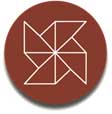
Factors that will guide your choices:
Style
The style of your existing or new kitchen will in large part have an influence on the type of knobs or pulls your choose.
Whether your kitchen is traditional, modern, country or eclectic, we will have a style to complement. Take your cue from the lines in the kitchen: if countertops and cabinet doors have simple, clean lines, then choose the same for your hardware. If however your cabinetry has detailed panelling and the countertops are rounded, you can choose hardware with softer, more ornate lines.
When searching for knobs or pulls, use the style filter in the left side bar to help you find the perfect fit. And remember to have a look through our style
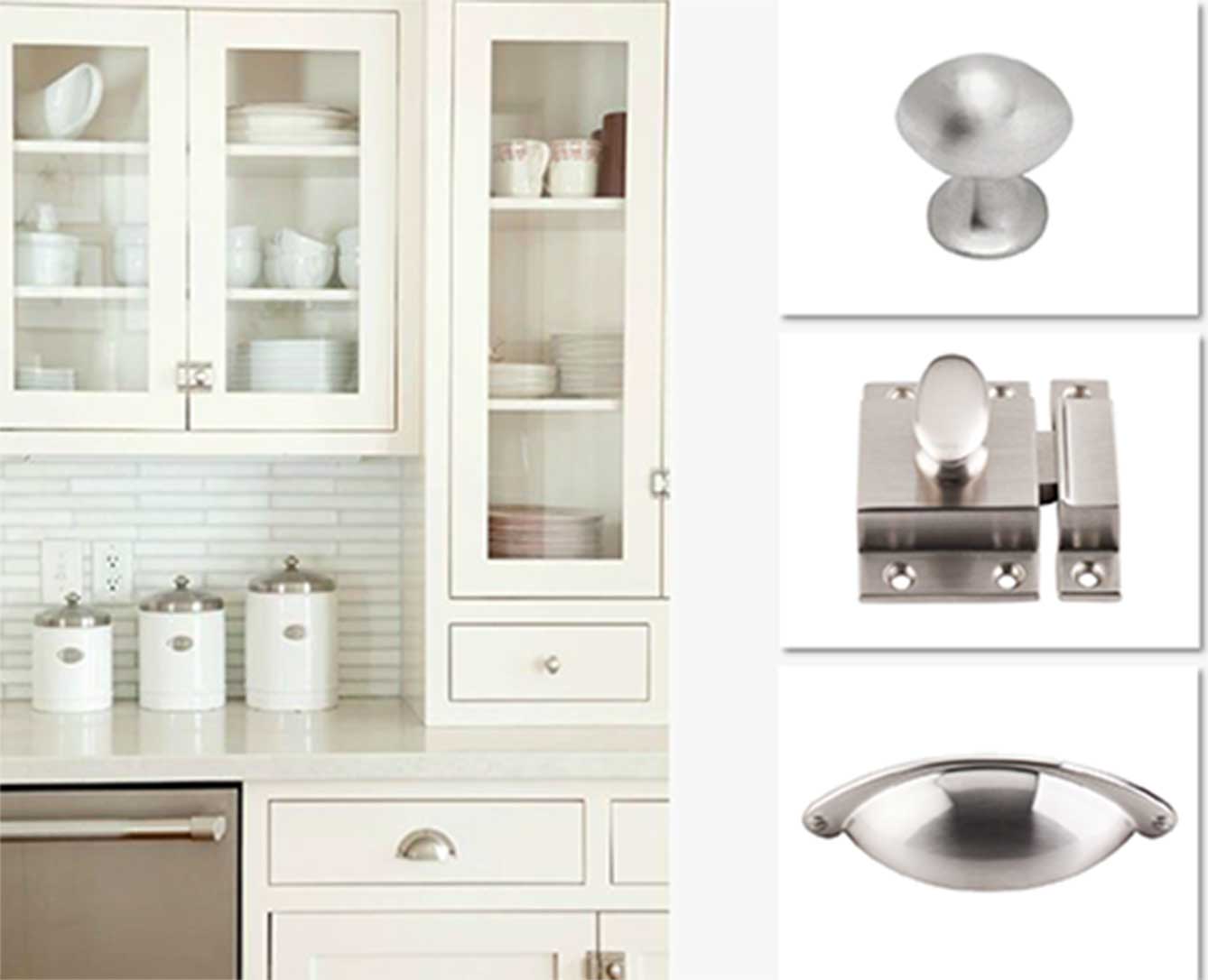
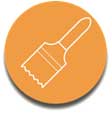
Factors that will guide your choices:
Finish
While not everything in your kitchen has to be the same finish, you will achieve a more cohesive look in the room if your handles tie in with another fixture like a light fitting, faucet, or appliance.
The number of finishes available is almost as vast as the number of styles, so take your time to choose the finish that will work best. Remember that you can always call on one of our designers for help, or order a selection of samples to help with your decision. Once you are confident that you have found the finish you're after, you can match that finish to your chosen style to determine the ultimate hardware for your kitchen.
Refer to our finishes section in this guide for an overview of what is available on Knobs.co.
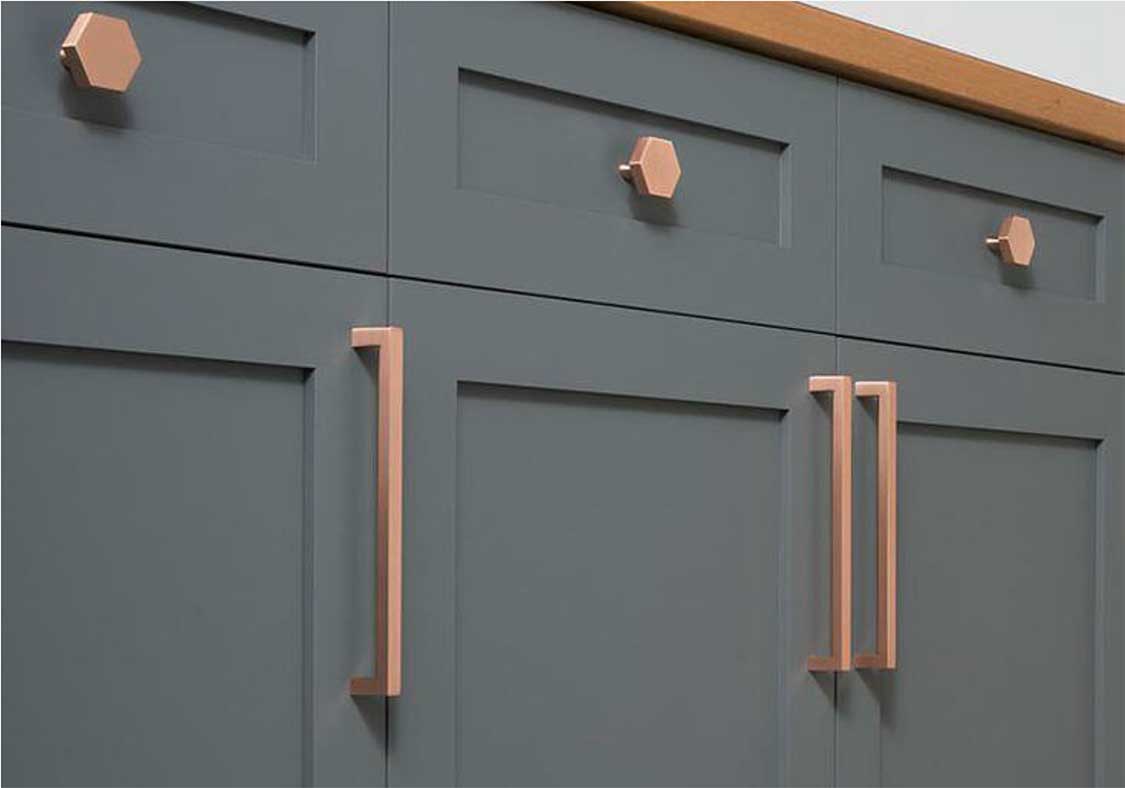
![]()
Factors that will guide your choices:
Pre-Drilled Holes
If you are replacing only the cabinet pulls or are refurbishing existing doors, then the holes made by the removed hardware will determine the size of the pulls you can install. Define your search by the width of the drill holes for accuracy of suitable options.

![]()
Factors that will guide your choices:
Practical Considerations
Consider your lifestyle and family setup: should little hands also have access to cabinets or do you purposefully want to keep them out? Do some family members struggle with delicate hardware?
You should also consider that protruding handles could potentially be a hazard in a very small kitchen or in an area like a busy walkway where space is limited.

![]()
Factors that will guide your choices:
Budget
As with any renovation project, the budget will have an influence on the products that you choose.
Typically, mass-produced hardware are much more affordable than custom made pieces. Custom pieces are mostly made by hand, adding to their price tag. These pieces may also be finished in precious metals like silver or gold plate, and are adorned with crystals and other semi-precious stones.
Rest assured, however, that with our vast range, you are sure to find cabinet hardware that will suite both your kitchen and your pocket.

Before we get into the detail, let's first look at a few basic definitions.
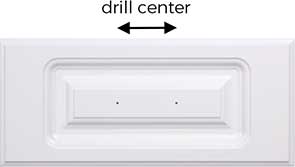
Drill center: the distance from the center of your first drill hole to the center of the second drill hole. This measurement is needed to find the proper size pull whenever your cabinets are pre-drilled. The most common sizes are 3", 3 ¾" (or 96mm), and 5" (or 128mm).
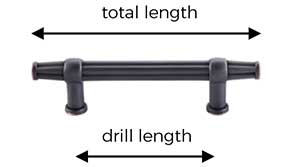
Total Length: The total length is from one end of the pull to the other, and will always be longer than the drill center.
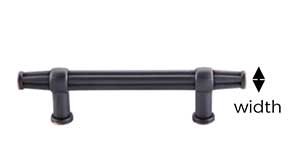
Width: this is how wide the pull is

Projection: this measurement is how far away from the cabinet does the hardware stand. This is the space where you would put your hand or fingers to open the door or drawer.
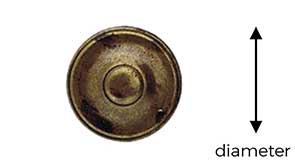
Diameter: most often thought of with knobs, this measurement is how large the knob is. The most popular size is the 1 1/4" diameter knob although sizes vary from 3/4" to up to 2' in diameter.

Screws: almost all screws are the standard 8/32 thread 1" long screws. There are some products that will come with multiple screws to allow you to use your hardware with thicker or thinner cabinet drawers or doors.
Tips on
Positioning & Installing Cabinet Hardware
Installing your cabinet hardware can be a pretty simple task that you can do yourself. Here will be helpful tips on how to plan and measure your cabinets and drawers to install your hardware like an expert
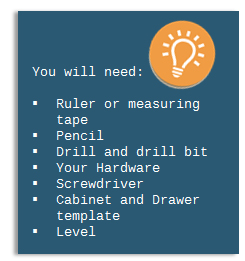 Drawers:
Drawers:
Positioning your hardware on drawers is quite simple. Typically knobs and pulls are centered on the face of the drawer. Drawers longer than 24" require a bit of extra hardware. These large drawers carry heavier loads. To prevent wear and tear on your drawer slides you can do one of the following:
- Use two knobs or two smaller pulls
- Use longer pulls 8-15"
- Use an appliance pull.
To find the center of your drawer measure from both the sides, as well as from top and bottom.

To center your pull on the face of the drawer, first find the center of the drawer as you did for the knob. Take the length of the drill centers of the pull, and divide by two. Then measure that distance from either side of your center mark. You can also use a template to ensure accuracy. For example: If you have 3" drill centers, mark 1 ½" on both sides of the center mark. To make sure your pull will be straight, use a level before drilling.

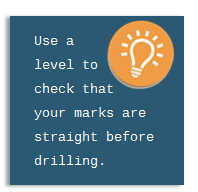 For drawers that require multiple pieces of hardware:
For drawers that require multiple pieces of hardware:
It is important for the knobs to be equally spaced, so that both pieces are carrying the same load, preventing wear on one of the pieces.
Also, make sure the marks are centered vertically on the drawer

For placing multiple pulls on the same drawer, divide the face of the drawer into three equal parts. From here, measure half the length of the pull on either side of these marks. Double check that these marks are centered vertically on the drawer.
If you have drawers stacked on top of one another, make sure that all the holes line up vertically from drawer to drawer before drilling!
For deep drawers, like pull out trash bins, the pull will be placed towards the top of the drawer. Find the center as you did for the other drawers.
Bigger drawers like these and deep pot drawers will require bigger hardware to help carry the load. For styles like Shaker cabinets that have prominent borders, find the center of the border. Once you have found and marked the center, take half of the length of our pull and measure that on both sides of the center mark.
Placing knobs on Lower Cabinets
There are two ways to place knobs on lower cabinets. In both methods, the knob is placed in the upper corner of the cabinet, opposite of the hinges.
Method 1: Center of Corner
Evenly measure from the top and nearest side to place the knob. Some cabinet styles such as Shaker have prominent borders on the cabinet door. To get an even-centered look for the knob, measure the width of the vertical panel, and height of the horizontal (usually are equal).
In the top corner, again opposite of the hinge, measure half of the width, and half of the height to find the center. Before drilling make sure the knob is level with cabinets on either side.
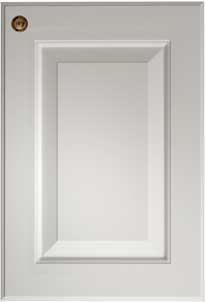
Method 2: Top Aligned
For this method, the measure the center of the vertical border opposite the hinges. This time, the top of the knob will be aligned with the bottom of the top border. To place your drill hole, you will need to know the diameter of your knob. Take half of the diameter (or radius) of the knob, and measure that down from the bottom of the top border.
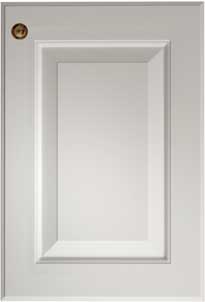
Placing Pulls on Lower Cabinets
Pulls on lower cabinets can be placed in one of two ways, much like placing knobs, except you will need to place the second hole. The two styles are once again centered in the corner, or top aligned. These two methods are for determining where you want to place the top of the pull. For pulls that have edges that extend out from the drill center, use the Top Aligned method to ensure the hardware doesn't stick out past the top edge of the cabinet
Method 1: Center of Corner Evenly measure from the top, and nearest side to place the first drill hole. Some cabinet styles, such as Shaker, have prominent borders on the cabinet door. To center the first drill hole, measure the width of the vertical panel, and height of the horizontal. In the top corner, again opposite of the hinge, measure half of the width, and half of the height to find center. Once you have placed the mark for your first hole, measure the length of your hardware's drill center and mark the second. Use your level to ensure you marks are even before drilling.
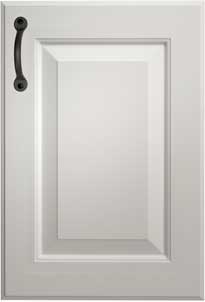
Method 2: Top Aligned
For this method, the measure the center of the vertical border opposite the hinges. This time, the top of the pull will be aligned with the bottom of the top border. (see image below). If your hardware goes past your drill centers, you mark the drill center right on the border line. Mark your drill hole in the center of the vertical panel. Once you have placed the mark for your first hole, measure the length of your hardware's drill center and mark the second. Use your level to ensure you marks are even before drilling.
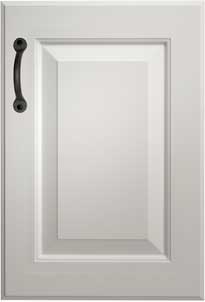
Placing Knobs on Upper Cabinets
There are two ways to place knobs on upper cabinets. In both methods, the knob is placed in the lower corner of the cabinet, opposite of the hinges.
Method 1: Center of Corner Evenly measure from the top and nearest side to place the knob. Some cabinet styles such as Shaker have prominent borders on the cabinet door. To get an even-centered look for the knob, measure the width of the vertical panel, and height of the horizontal (they are usually equal). In the bottom corner, again opposite of the hinge, measure half of the width, and half of the height to find center. Before drilling make sure the knob is level with cabinets on either side.
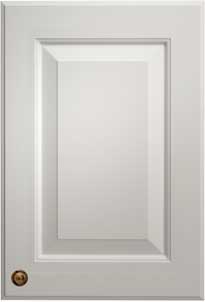
Method 2: Bottom Aligned
For this method, measure the center of the vertical border opposite the hinges. This time, the top of the knob will be aligned with the top of the bottom border. To place your drill hole, you will need to know the diameter of the knob. Take half of the diameter (or radius) of the knob, and measure that down from top of the bottom border.
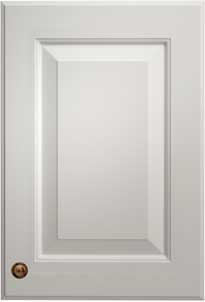
Placing Pulls on Upper Cabinets
Pulls on upper cabinets can be placed two ways, much like placing knobs, except you will need to also place the second hole. The two styles are once again centered in the corner, or bottom aligned. These two methods are for determining where you want to place the top of the pull. For pulls that have edges that extend out from the drill center, use the Bottom Aligned method to ensure the hardware doesn't stick out past the top edge of the cabinet.
Method 1: Center of Corner Evenly measure from the bottom, and nearest side to place the first drill hole. Some cabinet styles, such as Shaker, have prominent borders on the cabinet door. To center the first drill hole, measure the width of the vertical panel, and height of the horizontal. In the bottom corner, again opposite of the hinge, measure half of the width, and half of the height to find center. Once you have placed the mark for your first hole, measure the length of your hardware's drill center and mark the second hole. Use a level to ensure the marks are even before drilling.
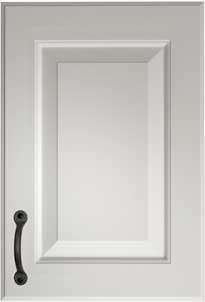
Method 2: Bottom Aligned
For this method, measure the center of the vertical border opposite the hinges. This time, the bottom of the pull will be aligned with the top of the bottom border. If your hardware goes past your drill centers, mark the drill center right on the border line.
Mark your drill hole in the center of the vertical panel. Once you have placed the mark for your first hole, measure the length of your hardware's drill center and mark the second hole. Use a level to ensure you marks are even before drilling.
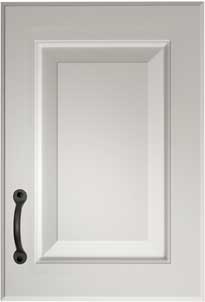
Knobs come in all shapes and sizes. Here are some of the most popular ones.
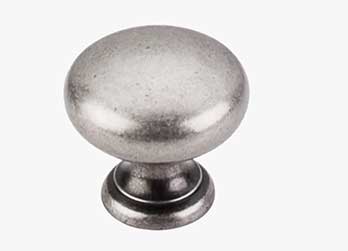
ROUND
The most popular kind, this shape can be used for both cabinet doors and drawers. They can vary from very plain to highly decorative
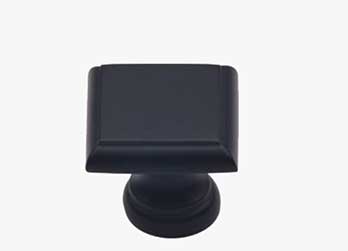
SQUARE
The slightly less traditional version of the round knob, square knobs add a contemporary finish to your kitchen cabinets.
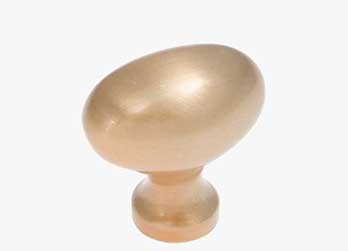
OVAL / FOOTBALL
Suitable to both traditional and more contemporary kitchen, oval knobs are very easy to use and work well on both doors and drawers.
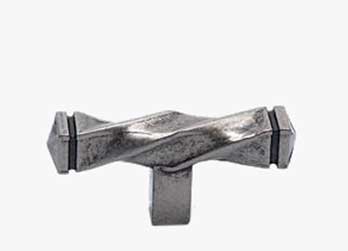
PULL KNOB / T-KNOB
Another style that works very well for people who struggle with gripping a knob, the pull knob makes opening drawers and doors simple.
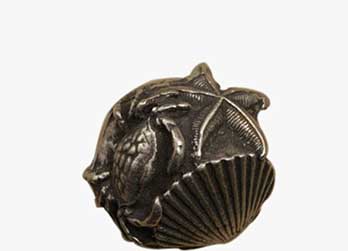
NOVELTY
Add a little something unique to your kitchen cabinets with hardware in anything from a nautical to an equestrian theme.
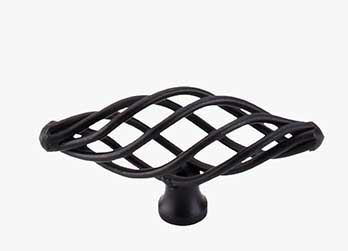
ORNATE
Pretty little knobs that really show your attention to detail.
Pulls come in all shapes and sizes. Here are some of the most popular ones.
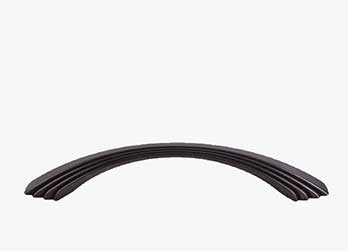
CURVED
Delicately curved pulls are great for kitchens where softer, curved lines form part of the design.
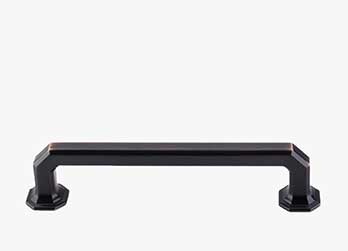
STRAIGHT
These pulls come in a large variety of styles and are suitable for both traditional and contemporary kitchens.

CONCAVE
Suited to traditional and industrial kitchen, cup or bin pull make a feature of your drawers.
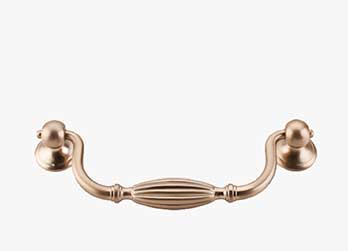
DROP
Perfect for more traditional kitchens, drop pulls come in a variety of sizes and finishes.
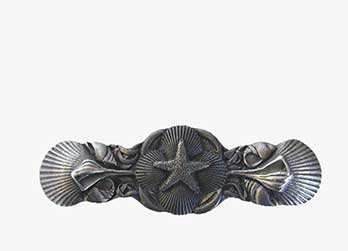
NOVELTY
Created to resemble animals, plant life and a large variety of other themes, these handles will make a statement in your kitchen
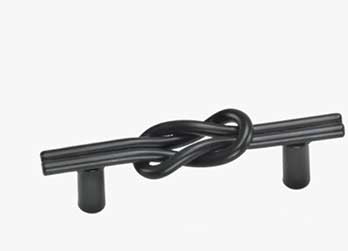
ORNATE
Added details to create unique pieces, these pulls will liven up an otherwise plain kitchen.
Looking at
Different Design Styles

MODERN
Based upon mid-century modern design, its an American adaptation of a mid-century European movement. It simple, clean lined style and the integration of natural materials.
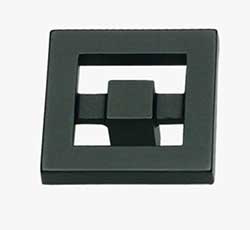
CONTEMPORY
This design style refers to a modern turn of the century movement. This style is made up of metallics, clean lines, and bold statements.
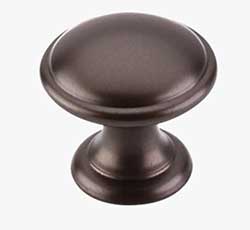
TRANSITIONAL
The marriage of traditional and contemporary styles, resulting in a timeless aesthetic. It's also referred to as classic contemporary, making use of the classic shapes of traditional hardware with less ornate detailing.

TRADITIONAL
Incorporating design from a variety of eras, creating a style that is both comfortable and elegant, It features warm, rich and inviting colors. This style may have curves and delicate details but it is not very ornate.
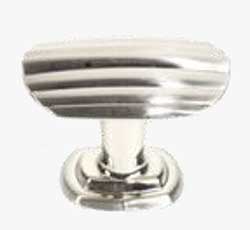
ART DECO
Inspired by the movement of the same name in the 1920's and 1930's, Art Deco consists of bold geometric forms, sleek appearance, and linear detailing.
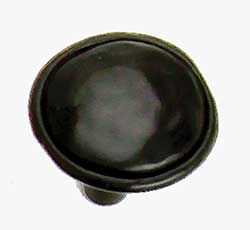
ARTISAN INSPIRED
Pieces that are inspired by the people who design it. Ranging from hand crafted and hand finished items to pieces inspired by the design eras of masonry and carving.
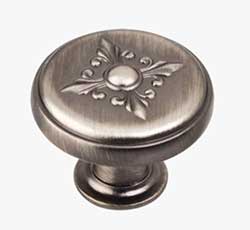
FRENCH COUNTRY
An extremely popular design style that has been influenced by traditional French design with a rustic touch. This European style is elegant as well as comfortable and welcoming.
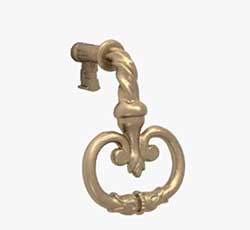
WHIMSICAL
This design style is for unique, quirky and one-of-a-kind items. They can abstract or based on a variety of non-conventional themes. This is a good category to look into for clients who are looking for a statement piece.
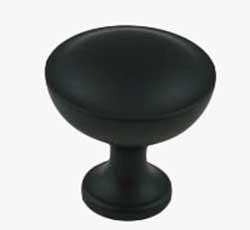
TIMELESS CHARM
This category is for classic, timeless pieces - those that withstand the change in styles.
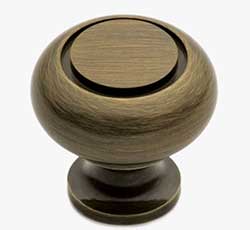
CLASSIC CHARM
This category is for pieces with a simplistic, classic beauty that will go with just about anything.
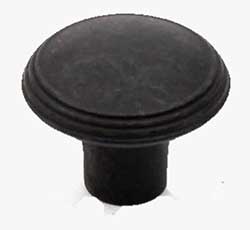
COUNTRY
This style is influenced by the simplicity of materials and style of rural areas.
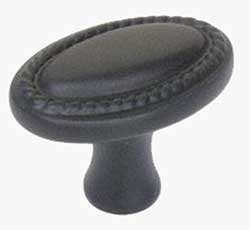
EUROPEAN
This category is for items with a European flavor. This ranges from Victorian, ornate to more modern and clean pieces.
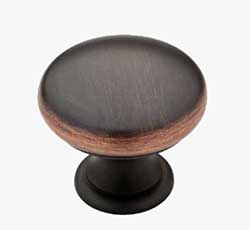
RUSTIC
This style is unpolished or aged. Typically simple in design and it can have a hand made, masonry or hammered appearance. Not everything with an antiqued appearance will be rustic however; this style is simple and possess little detail.
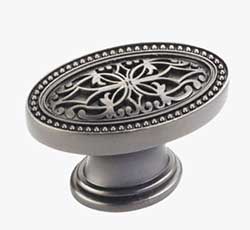
ORNAMENTAL
Also known as embellished or decorated, this style is highly detailed and decorative with patterns, depictions of nature, or human figures. There is also a tendency for mixing materials like metal and stone or jewels.
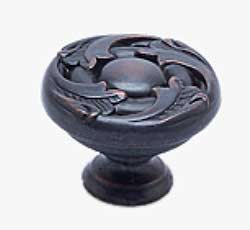
ARTS & CRAFTS / CRAFTSMEN STYLE
Traditional craftsmanship using simple forms, and often medieval, romantic, or folk styles decoration. It's a mix of ornamental and transitional. While the overall shape of the item is simplistic, it has decorative details or patterns.
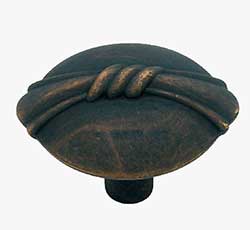
EXPRESSIONS
Hardware for clients that want to make a statement. Containing modern pieces that are unique with abstract shapes and incorporating crystal knobs, hand crafted items and even some transitional items with flare

UPTOWN ALLURE
This is a style for the urban uptown areas, the kind of hardware you would find in uptown studios or condos. It is an elegant mix of modern and contemporary, simple metals, without much detailing. .
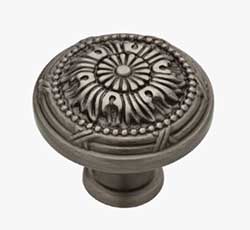
VICTORIAN
This design style is based from a design era in Europe primarily in France. This was a design area full of ornate designs, highly detailed. Strong use of gold, but also of various colors used to bring out detail or ornamentation.

INDUSTRIAL
The finishes on industrial pieces can be either rustic/dull/antiqued or polished or brushed. The fittings can either have an iron look reminiscent of an old factory, or polished chrome, stainless steel and nickel like in an industrial kitchen. .
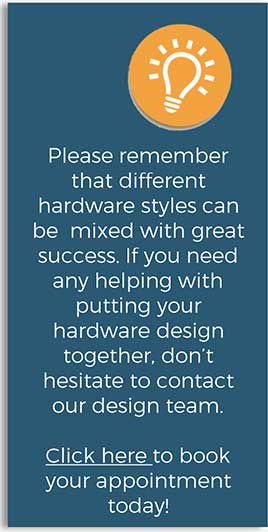

The most important thing to know when choosing a cabinet hardware brand is that almost all hardware these days is either mass-produced overseas or custom made in the US.
Mass produced hardware and custom-made hardware each have their advantages. Just deciding which type is the best fit for your home will already cut your options in half

Imported Hardware
Almost all cabinet hardware sold in the US is made in China (although even some Chinese companies have started moving their factories to Vietnam for lower labor rates).
PROS: Mass-produced lines are less expensive, and are usually available to be shipped out immediately.
CONS: On the rare occasion when they do go out of stock, there will often be a wait of several months before they're available again since they're being sourced from so far away.
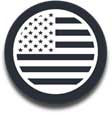
Domestic Hardware
Domestic hardware is mostly custom made pieces, designed for a specific project.
PROS: The advantage of these lines is that they tend to be made from higher quality materials, come in a far wider variety of finishes (since no one needs to hold stock), and tend to have more innate charm and personality. Also, there's never any issue with availability, as they're custom made for each order.
CONS: they are usually more expensive and have longer lead times to produce.

Cabinet hardware
Base Materials

Aluminium is a soft, highly durable, lightweight and malleable metal. It is usually coated during finishing. .

Zinc alloy is the most commonly used metal in mass produced hardware because of its low cost, strength and die casting capabilities. Zinc is used as a base metal for coating. In spite of its lower cost, it is of very high quality with most brands guaranteeing their zinc hardware for life.

Brass is another alloy, made up of zinc and copper. Where traditionally, it would need a regular polish to keep it looking great, brass knobs can now be lacquered with a clear coating to keep its luster.

Bronze is an alloy of primarily copper with about 12% tin and typically with the addition of other metals like aluminium, manganese, nickel or zinc for strength

Iron is one of the oldest hardware options and is typically available as cast iron products. These types of hardware are ideally suited to rustic or industrial style kitchens.

Stainless Steel is a steel alloy with chromium, giving it its superior stain- and corrosion resistance properties. Highly suitable for hygienic environments as it can be steam-cleaned and sterilized.

Solid Wood knobs can come in a variety of styles, they come in lacquered and raw wood. Raw wood hardware can be stained to match your cabinets. They can also be painted or left raw. They are shaped and sanded, creating a smooth natural unique item.

Marble is an incredibly hard and durable natural stone. It is suitable for both traditional and modern kitchens and can be combined with a number of metals to create a desired look.

Plastic is one of the most inexpensive hardware materials, While it is not as durable as metal, it very popular because of the incredible variety of colors and styles available
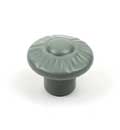
Ceramic is baked clay. The properties of the clay allow for a multitude of designs and colors. The product can be glazed or unglazed
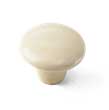
Porcelain is white clay and is a very traditional material for cabinet hardware. It is available in a variety of colors and some designs also have traditional flower designs glazed onto them.

Resin is a highly viscose substance that can be poured into a mold, where it sets to a clear solid. Resin can have different particles included in the solid to add interest. It's very lightweight and durable, making it a popular choice.

CrystalCrystal is classified as a highly transparent glass with a high refractive index. Crystal hardware is cut to have faceted faces to allow for the beautiful display of light, creating a sense of luxury and glamor.

GlassGlass comes in a variety of shapes, colors and opacities. Glass can be cut to mimic crystal or can come in flat shapes. Simple glass knobs are elegant and suited for both traditional and contemporary kitchens, while our colorful glass options can be used to match back splashes, or to liven up a room using pops of pattern and bright colors.
Cabinet hardware
Finishes

NICKEL
is one of the most common finishes, it is durable and wears well. It is darker than chrome, can have a warmer hue. Nickel hardware will not rust, fade or weather.

CHROME
or chromium plating is a decorative and protective finish over a base metal like brass or zinc. Chrome is generally polished to give it a high luster.

COPPER
is a very unique finish. Unlacquered it is a living finish, meaning it will patina by forming a black-brown layer when it reacts with oxygen and oils from use. When lacquered it maintains the great copper tone throughout the life of the piece.
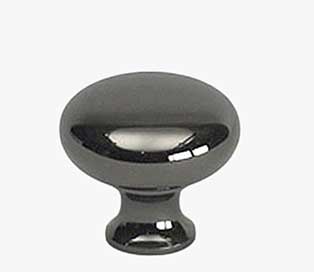
BLACK NICKEL
is a very clean sophisticated finish. It creates a very modern and regal look. Black nickel is also popular, it is a bright polished finish.
The most popular
Finish Treatments
There are literally thousands of finishes available for metal hardware, but only a few of our major finish treatments that you need to know about.
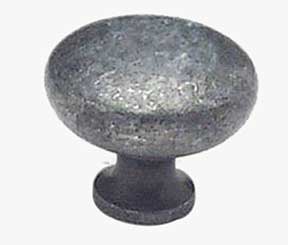
ANTIQUED, BURNISHED OR DISTRESSED
These finish create a natural aged or patina on the hardware bringing out detailing and imperfections. Materials: Brass, Bronze, Copper, Nickel and Pewter Ideally suited to rustic and industrial styles.
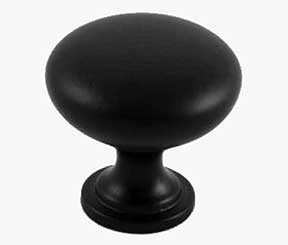
MATTE
A coat applied to protect the metal with no sheen. The most popular matte finish is Matte Black. Materials: Nickel, Copper, Brass, Pewter Works well in contemporary and sophisticated settings.
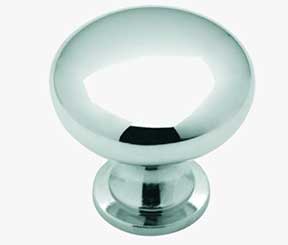
POLISHED
Polished hardware can be both refined and contemporary. While regular buffing is required to keep the look, the beautiful luster is well worth it. Materials: Brass, Chrome, Nickel, Copper, Bronze Works very well in both a traditional and contemporary setting.
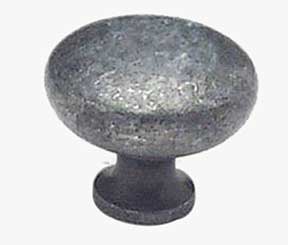
ANTIQUED
Another finish that brings out the natural character of hardware, this finish makes the item look well-worn after years after continued use. Materials: Iron, Wood, Brass, Bronze, Nickel, Pewter, Copper Another great addition to your rustic, traditional or country kitchen.
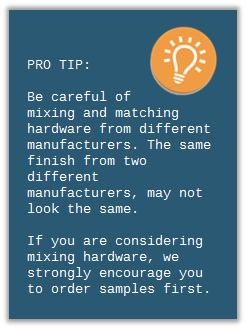
A little more about
Bronze Finish Treatments
Oil Rubbed Bronze comes in many different colors. This technique is the application of multiple finishes. A metal is coated in an brown lacquer then brushed off or distressed revealing a metal underneath. It is important to understand that each bronze will vary between brands.

OIL RUBBED BRONZE
A medium bronze overtone, with a copper undertone
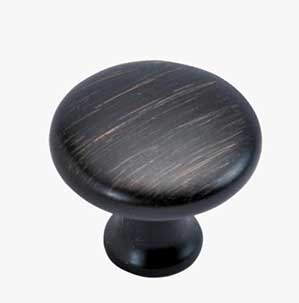
VENETIAN BRONZE
Typically a very dark brown overtone, with a brass undertone.
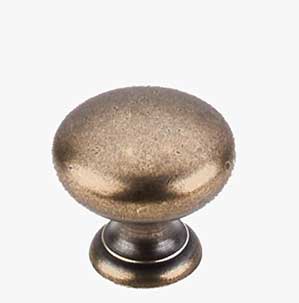
GERMAN BRONZE
Similar to Venetian bronze, however a medium brown lacquer with heavy distressing revealing a prominent brass tone.
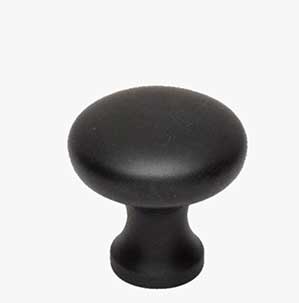
CHOCOLATE BRONZE
A solid medium brown lacquer with almost little to no distressing
At Knobs.co, we don't only stock knobs and pulls. You can get a multitude of products right here on our site.
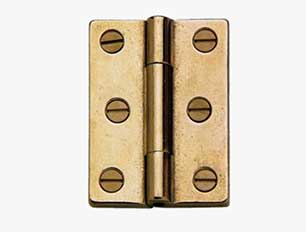
CABINET HINGES
When it's time to purchase your hinges, find the ones that will complement your cabinets the best. From strap and H-style hinges on bead board and country-style doors, to concealed, clip-on hinges in contemporary kitchens, your new cabinet hinges should fit seamlessly into the rest of the design
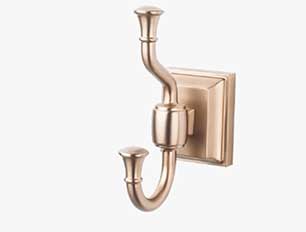
BATHROOM HARDWARE
Our extensive range of bathroom accessories include towel rails, vanities, toilet accessories and cabinets. Available in a vast range of finishes and designs, you are sure to find the perfect accessory for your bathroom sanctuary.
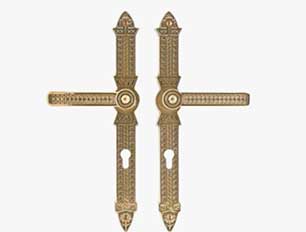
DOOR HARDWARE
Catches, latches , locks and handles – we stock everything you need to make your doors function perfectly. Browse through our door hardware section to find the right style for your home.
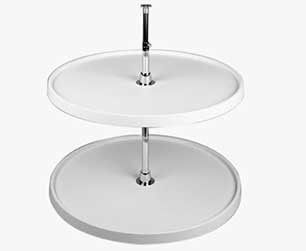
CABINET ORGANIZERS
An organized cabinet is a functional cabinet. Make your storage spaces work optimally by adding cabinet organizers. Click here for the full range.


Natural Rock Drawer Knobs and Cabinet Pulls
Source: https://www.knobs.co/cabinet-hardware-guide/